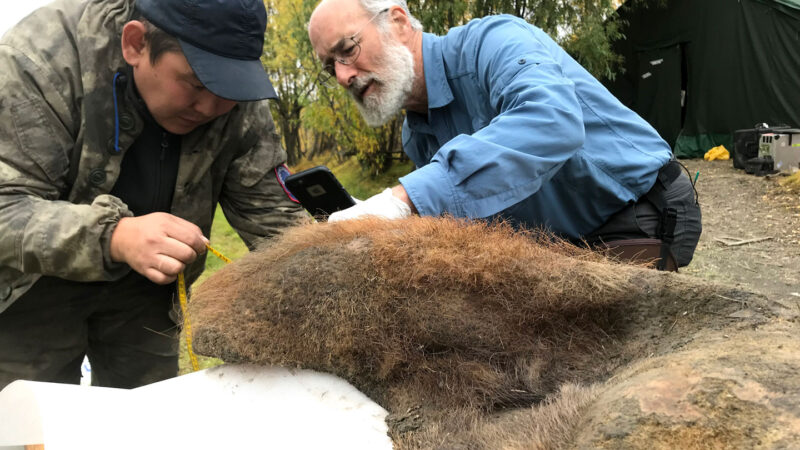What do beef jerky and some woolly mammoths have in common? Drying turns their DNA into super-tough glass.
DNA in this form is extremely stable. In fact, scientists have now found such glassy DNA from a woolly mammoth that has held its 3-D shape for 52,000 years. The team shared its finding July 11 in Cell.
The discovery offers a never-before-seen look at woolly mammoths’ genetic instruction book. It even shows which genes — bits of DNA related to different traits — were active or quiet before the mammoth died.
Samples like this could reveal more about how these and other extinct creatures functioned.
DNA is a molecule that contains genes. Every cell of an animal needs the instructions in these genes to do its job. Inside the nucleus of each cell, long pieces of DNA are packaged into bundles called chromosomes. To cram meters (feet) of DNA into a space so small that you need a microscope to see it, cells have to coil it. And wind it. And fold it. And loop it.
That makes the chromosomes look messy. But don’t let the tangles fool you. The DNA inside chromosomes is organized into very careful structures. Those structures determine how the DNA’s genes work — and, in turn, how the whole life form works.
Visualizing that instructional material
Scientists can peer at the 3-D structure of DNA inside a cell’s nucleus using a technique called Hi-C. It’s like chemical freeze tag. Scientists use chemicals to freeze the DNA in place. Then, they examine it to see which pieces of DNA touch each other. That tells them how the DNA is folded in the cell.
Hi-C usually requires fresh, intact samples. Until now, no one had applied it to ancient DNA. That’s because DNA crumbles over time.
It was therefore hard to imagine that tiny bits of ancient DNA could retain the shape of chromosomes, says Christina Warinner. She was not involved in the new research. But she does study ancient remnants of life’s molecules at Harvard University in Cambridge, Mass.
Do you have a science question? We can help!
Submit your question here, and we might answer it an upcoming issue of Science News Explores
Cynthia Pérez Estrada studies genetic material at Baylor College of Medicine. That’s in Houston, Texas. She thought Hi-C could work on degraded DNA. So she tested Hi-C on all types of old tissue samples. Turkey bones left over after Thanksgiving dinner. A dried-out roadkill mouse she found on her way to work. A piece of leather from her bag.
“All of those experiments were fascinating,” she says. “It actually showed that the structure of the DNA is pretty resilient … despite the cooking, and despite the sun and the environment (when talking about the mouse). The structure of the DNA was still there.”
Examining ancient DNA
Even after all her tests, Pérez Estrada didn’t know whether DNA’s structure could hold up for thousands of years. So she teamed up with Marcela Sandoval-Velasco. This researcher had been working on ancient DNA and was keen to probe its 3-D structures. She is currently based at the National Autonomous University of Mexico in Cuernavaca.
Sandoval-Velasco brought “a bag full of wonders” to Houston for testing, Pérez Estrada says. Those wonders included museum specimens of ants, bees, fish, reptiles and birds. Pérez Estrada also visited Denmark, where Sandoval-Velasco was then working at the University of Copenhagen. There, the researchers probed ancient polar-bear skulls and a mummified wolf.
The experiments often failed. The Hi-C method used on fresh samples didn’t work on ancient ones. So a new version had to be invented. The team called it PaleoHi-C.
These kinds of workarounds are common in research, says Sandoval-Velasco. Science is “full of failures, and it’s about not giving up.” Teamwork helps too, she says. More than 50 scientists with different expertise came together for the mammoth study.
Freeze-drying preserved the DNA of a woolly mammoth that died 52,000 years ago. It morphed into a tough molecular structure called chromoglass. The mammoth’s foot is visible here to the right of a person’s legs.Love Dalén/Stockholm University.
After years of partial success and failure, the team got access to skin from the head of a woolly mammoth. This animal died in Siberia about 52,000 years ago. Its tissue was naturally freeze-dried and then preserved in a layer of frozen soil called permafrost.
Rapid drying had locked the mammoth’s DNA into a tight molecular state — one similar to glass. This “chromoglass” kept the pieces of ancient DNA from drifting apart.
Using lab-made beef jerky, the team tested how long such glassy DNA can remain stable at room temperature. They found it could last at least a year. It also could withstand being microwaved, run over with a car and blasted with a shotgun.
Watch researchers slice a sample from 52,000-year-old mammoth skin. It provided the first-ever look at the 3-D structure of the extinct mammal’s DNA.
Dazzling details of mammoth DNA
The mammoth’s glassy DNA locked its chromosomes into place. This meant researchers for the first time could count how many chromosomes a mammoth has. The answer: 28 pairs — the same number as elephants. Mammoths also have the same basic chromosome structure as elephants.
The chromoglass also showed which regions of DNA, or genes, in the mammoth’s chromosomes had been turned on or off.
When a gene is turned on, it provides instructions for a cell to perform certain functions. When turned off, it does not provide these instructions.
Explainer: What are genes?
DNA’s shape is important for figuring out if a gene will be on or off. Inside a cell’s nucleus, there are different areas where genes are turned on and off. Think of it like a big crowded party. Some genes will be on the dance floor. They will be turned on. Other genes will stand against the wall. These wallflowers are turned off.
The researchers found 425 genes that were turned on in mammoths but not in elephants.
And they found 395 genes turned on in elephants but not in mammoths. Those included a gene called Egfr. It helps control skin and hair growth. In elephants, this gene was active. But it was a wallflower in mammoths. In people, switching off the gene leads to long, thick eyelashes and excessive hair growth. This hints that keeping the gene off the dance floor may have helped mammoths grow their long, shaggy coats.
The team looked at DNA from a second mammoth, too. This one was killed by a saber-toothed tiger about 39,000 years ago. Its remains also had chromoglass that preserved 3-D structures in its DNA. Quick drying by freezing or high heat might produce similar DNA glass in other natural or created mummies.
This work could inspire other scientists to use PaleoHi-C to get new views of their own ancient DNA samples, Warinner says. “I think it’s really exciting.” In fact, she adds, it “opens up a lot of new doors in the field — [and] in a direction that we just haven’t been looking before.”




